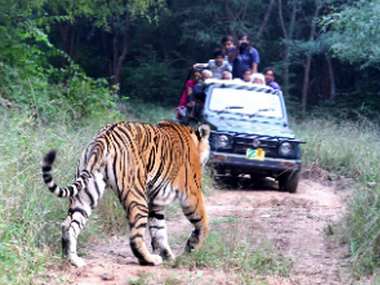With 40 percent of Rajasthan’s Sariska Tiger Reserve overrun by cattle, tigers are finding it difficult to survive. Condemned to live in the shadow of its big brother, the world famous Ranthambore Tiger Reserve 170 kilometers away, Sariska ’s inability to hold on to its big cats has dismayed wildlife enthusiasts and policy makers for decades. To paraphrase Murphy’s Law, everything which could have gone wrong has gone wrong. The reserve was emptied of all its tigers by poachers in 2005. Three years later, a relocation project was initiated under the aegis of the Prime Minister’s Office with Dr Sunayan Sharma appointed as the reserve’s field director. A tiger and two tigresses were trans-located from Ranthambore in the hope that Sariska would soon have a thriving tiger population once again. [caption id=“attachment_6810101” align=“alignleft” width=“380”]  The male to female ratio of tigers in Sariska Tiger Reserve has fallen to an abysmal 1:8. Image courtesy: Ajay Suri[/caption] “But we knew of Sariska’s unique problems then. They stand unresolved to this day,’’ says Sharma. The reserve is surrounded by 3,000-plus villages and each one of these send their cattle inside the grasslands every morning for grazing. No political party that has ruled Rajasthan during past three decades has shown the spine to act against this menace. Why? The vote bank. “Even when the relocation started, close to 40 percent of Sariska’s area was encroached upon by the villagers’ cattle. We just could not do anything. A strong political backing was required to clear the cattle mess, and it never came,’’ says Sharma. With the survival of the tiger hanging by its tail, Sariska has had to weather not one but two ‘vote bank onslaughts’ on its big cats. In 2008, when the National Tiger Conservation Authority (NTCA) in New Delhi earmarked more than 800 square kilometres in Sariska as Critical Tiger Habitat (CTC), it asked the state government to shift 29 villages which lay inside the area. As of June 2019, only three have been moved. Dinesh Durani, a wildlife expert with close bonds to Sariska for over two decades, says this singular lapse is perhaps the biggest example of a system failure in Sariska. The three largest and most problematic villages situated inside the tiger reserve are Haripur, Kraska and Kankwaadi. “With so much of the tiger reserve under constant threat and disturbance by these three big villages, as well as 23 others, how can anyone hope for the tiger’s future in Sariska?’’ asks Durani. Arindam Tomar, Rajasthan’s Chief Wildlife Warden, says fixing this issue is a priority now. “As a first measure, our aim is to move out at least half of the remaining 26 villages from Sariska. We are moving in that direction,’’ he claims. However, Durani is equally wary of another danger looming over Sariska’s tigers, one which has largely escaped notice – the genetic inferiority of the tigers relocated from Ranthambore. Due to the absence of natural corridors, Ranthambore’s tigers are inbred and thus of poor stock. Of all the tigresses brought into Sariska, only one gave litters twice. Another became a mother only once, while four tigresses did not give birth to a single cub. This is a pathetic record compared to flourishing populations in Corbett, Bandhavgarh and Tadoba. And with the male to female tiger ratio falling to an alarming 1:8 early this month, the Rajasthan forest department was forced to press the panic button. Last week, it urged the NTCA to suggest a viable option to the project. Barring probably Rajaji National Park in the foothills of Uttarakhand’s Shivalik hills, no other reserve has been such an embarrassment for the authorities. Durani, in repeated communications with the state’s forest department and the Rajasthan Government, has been urging them to bring tigers from areas other than Ranthambore. “This is so foolish, even a layman knows about the dangers of inbreeding. What has been stopping the authorities from procuring tigers from other states and regions?” Durani is right. Panna National Park in Madhya Pradesh was in a similar situation around the same time that Sariska’s tiger population was being denuded. However, owing to a conscious decision by the authorities to diversify the genetic stock by procuring tigers from Bandhavgarh, Kanha and Pench, Panna had more than 30 big cats by 2017. Panna’s rejuvenation has been helped immensely by huge public support for the tiger. In contrast, Sariska suffers from public apathy which is evidenced by thousands of squatters inside the reserve as well as daily cattle-driven assault on its grasslands by the villagers living on its boundaries. They were not concerned with the tiger then, nor are they now. The importance of public support for the tiger’s survival was grasped decades ago by Jim Corbett, that famous hunter turned protector of the big cats. Writing in Man-Eaters of Kumaon, Corbett remarked, “the tiger is a large-hearted gentleman with boundless courage and that when he is exterminated- as exterminated he will be, unless public opinion rallies to his support- India will be the poorer by having lost the finest of her fauna.’’ A near doomsday prophesy. Did Corbett by any chance have Sariska in mind?
Condemned to live in the shadow of its big brother, the world famous Ranthambore Tiger Reserve, Sariska’s inability to hold on to its big cats has dismayed wildlife enthusiasts and policy makers for decades
Advertisement
End of Article


)

)
)
)
)
)
)
)
)



